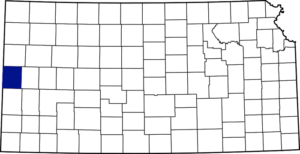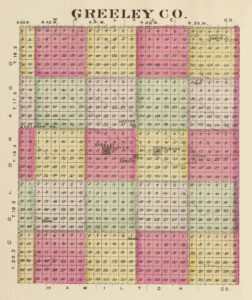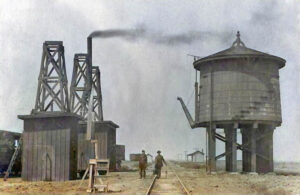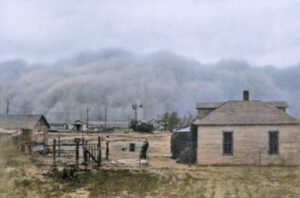Towns & Places:
Horace – Ghost Town
Tribune – County Seat
The Ghost of White Woman Creek
Greeley County, Kansas, on the western tier, is midway between Oklahoma and Nebraska. Its county seat and largest city is Tribune. As of the 2020 census, the population was 1,284, making it the least populous county in Kansas. The county is named after Horace Greeley, editor of the New York Tribune, who encouraged western settlement with the motto “Go West, young man.”
In 1873, Greeley was the last county in the state to be created. It is bounded on the north by Wallace County, east by Wichita County, south by Hamilton County, and west by the State of Colorado. The surface is prairie, with an elevation of 3,000 to 4,000 feet. The principal stream is White Woman Creek. The streams have no water in them for the more significant part of the year, but there are undercurrents, evidenced by water being found at a depth of a few feet.
In 1880, the population in Greeley County was only three, and they were here to hunt for buffalo bones. In 1885, ten people were in Greeley County, most of whom were herding livestock.
In the fall of 1885, more people began to settle in the county, and the first community created was Hector. In the next two years, many more people moved to the area, and several towns were established. So many towns were created that many people alleged there were more towns than there were claim houses. Horace was established in June 1886, and at the time of the county seat fight, it had 300 inhabitants, a bank, and a newspaper. Tribune had 200 inhabitants and a newspaper. Colokan was a little town large enough to have a newspaper. Reid was established in September 1887 and, within three months, had two stores, a hotel, two restaurants, and a newspaper. The Missouri Pacific Railroad was built in the early days of the county’s settlement, and a depot was erected at Tribune in 1887. It crossed almost directly east and west through the center.
In 1887, a census taker was appointed, and in June, he reported 2,638 inhabitants.
An injunction suit was filed to prevent the county from organizing based on bribery and fraud charges in the census. However, the injunction was not granted, and Governor John Martin proclaimed the organization in July 1888. Tribune was named the temporary county seat. The following officers were appointed: county clerk James W. Brown, sheriff Allen E. Webb, and commissioners A.J. Rymph, A.K. Webb, and R.Q. Thompson. Three townships were created, including Colony, Harrison, and Tribune.
The election to decide the permanent location of the county seat was held in November 1888 and resulted in Tribune’s victory. The first county courthouse, built in 1889-90, was a two-story sandstone building constructed by Allen, Oleson, and William Ruff, both of Ness City, Kansas.
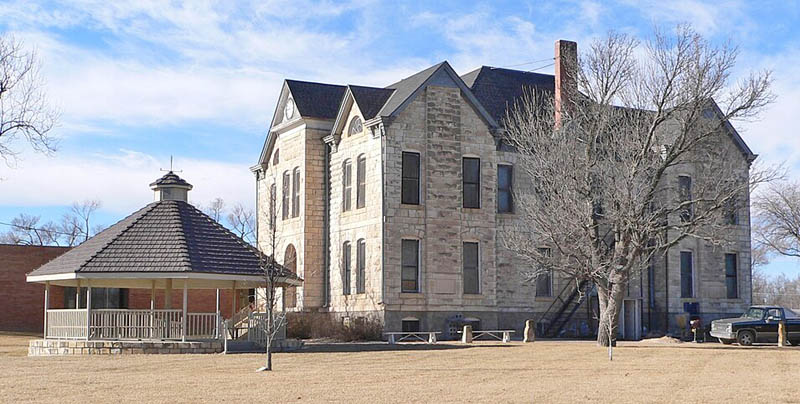
The old Greeley County Courthouse now serves as a museum. Photo courtesy Wikipedia.
In the late 1890s, people began to brand their cattle, with Robert Eadie being the first to register his brand in Greeley County.
From 1895 to 1920, Greeley County suffered from challenging economic and environmental problems, and the population decreased. Simon Fishman helped save Greeley County in 1920 when he put his money into developing the Pacific House in Horace and using modern tractors and machinery within the county. From 1920 to 1923, Greeley County started to grow once again.
By 1910, farm products were valued at $137,346, with sorghum, which is raised for forage and grain, being the most valuable. Other crops included barley and corn, and raising livestock was profitable. The population at that time was 1,335. There were 13 organized school districts with 232 students. The value of the taxable property was $3,531,197, making the average wealth per capita $2,720, which was several hundred dollars over the state average.
The Great Depression hindered Greeley County, as it did nationwide.
The county’s population grew in the following decades, reaching a peak of 2,087 in 1960.
A new county courthouse was built from 1973 to 1975 by contractor Ewing Construction, Inc.
The courthouse was built from 1973 to 1975 by contractor Ewing Construction, Inc. The modern-style one-story red-brick courthouse is on landscaped grounds at the city’s center. The old courthouse is located on the east side of the present courthouse grounds and houses the Greeley County Historical Society Museum.
©Kathy Alexander/Legends of Kansas, updated October 2025.
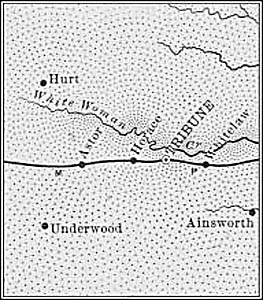
Greeley County, Kansas, vintage map.
Also See:
Sources:
Blackmar, Frank W.; Kansas: A Cyclopedia of State History, Vol I; Standard Publishing Company, Chicago, IL 1912.
Fort Hays University Forsyth Library
Genealogy Trails
Wikipedia


